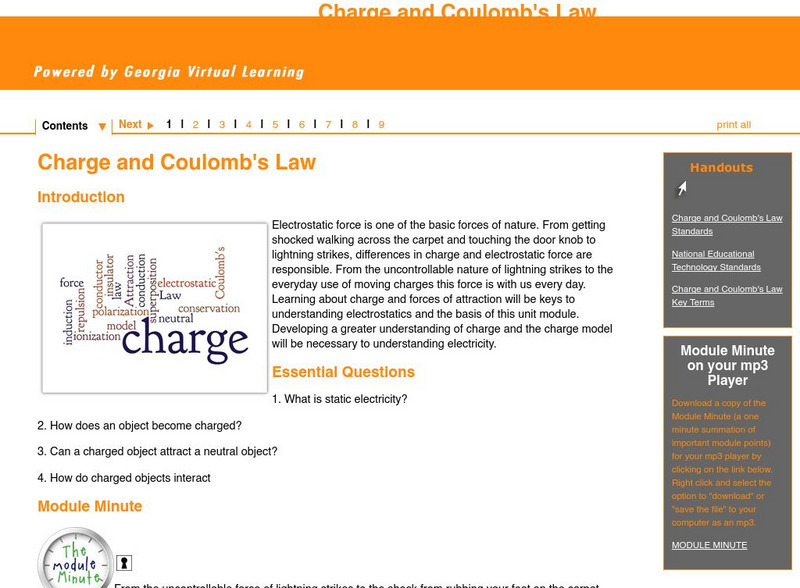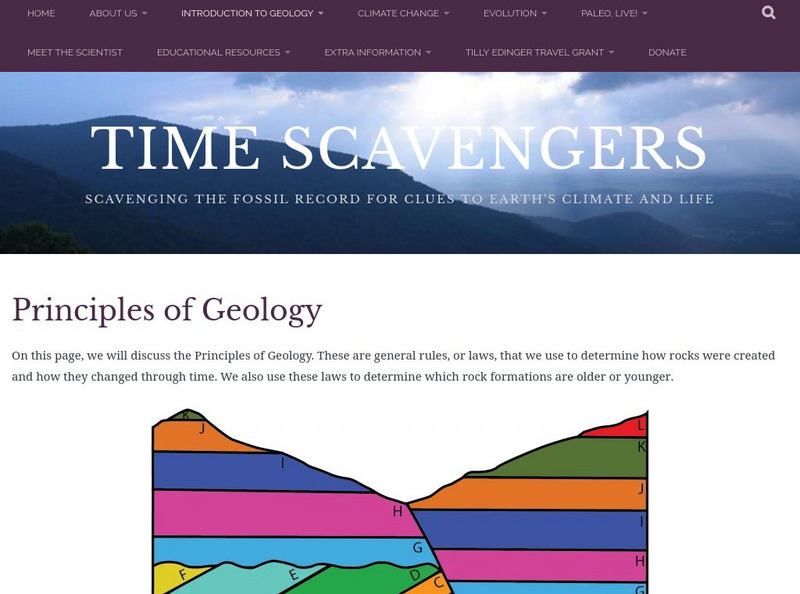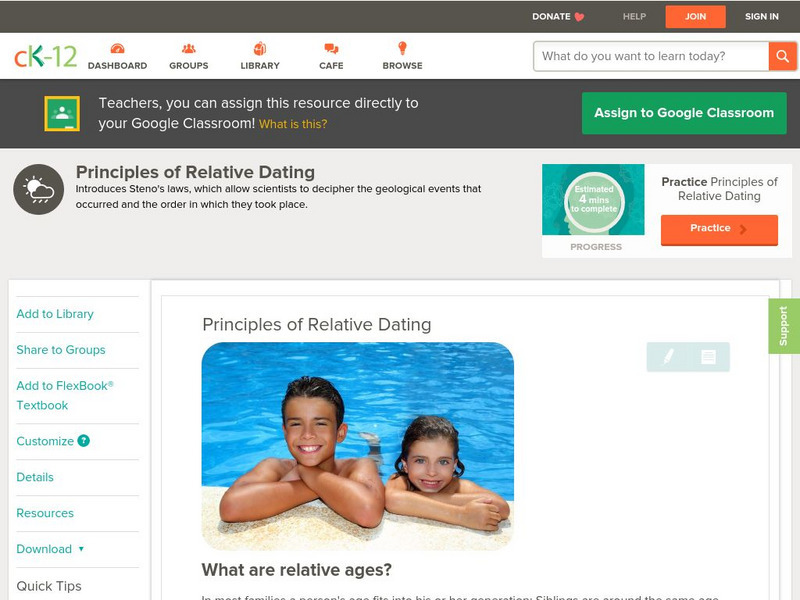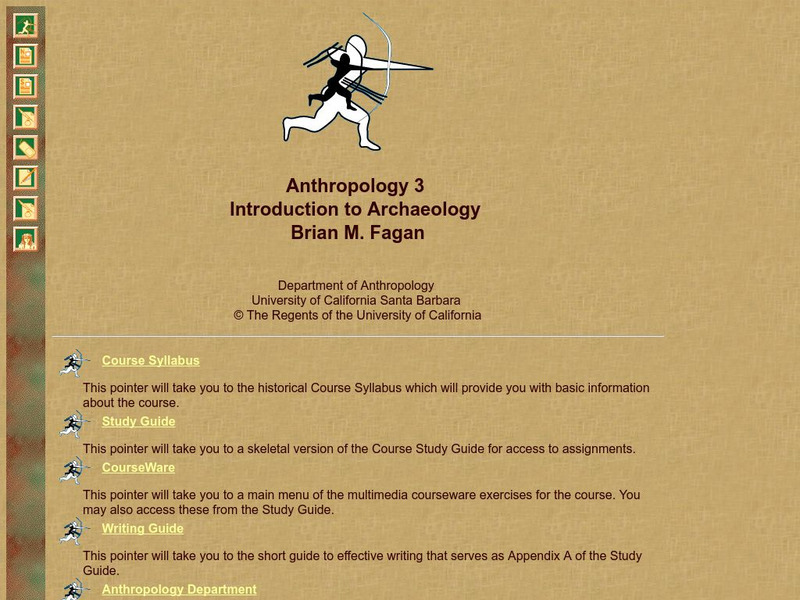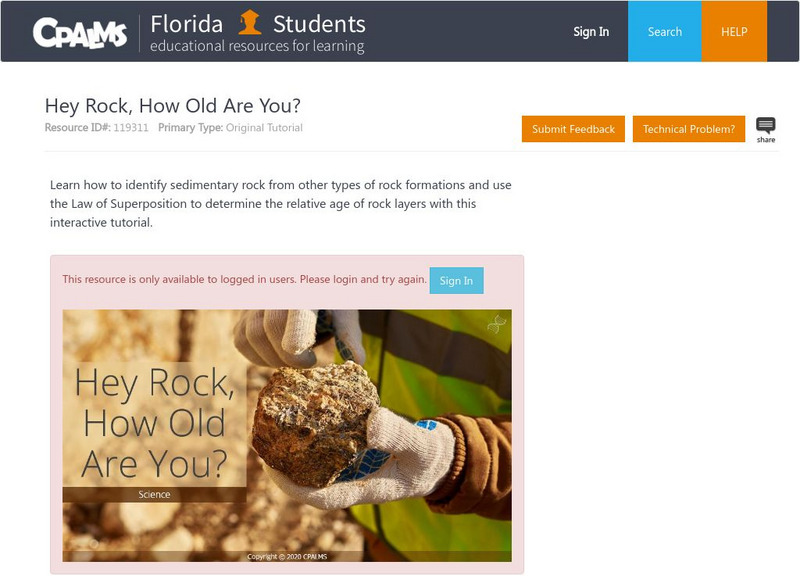Curated OER
Relative Dating in Archaeology
Students create a timeline that explains how ancient cultures used artifacts. In this Relative Dating in Archaeology lesson, students examine artifacts and draw conclusions about their origins. Then students analyze antiquated objects or...
Curated OER
Geologic Time
In this geologic time instructional activity, students review how fossils were formed and the events that mark the various geological eras and periods. This instructional activity has 10 fill in the blank and 9 short answer questions.
Curated OER
The Rocks Under Illinois
Pupils examine the rock layers in Illinois. They draw the many rock layers using the Geology website. They discover the arrangement of strata of rocks.
Curated OER
Geologic Time: Relative and Absolute Dating
Learners investigate relative and absolute dating; determine the difference between the two dating systems; and apply this knowledge by creating a geologic timetable of their own.
Curated OER
Describe and Interpret Images: Folded Strata
High schoolers describe and interpret images. They make a simple sketch of an outcrop shown in a slide (or computer projection) then discuss possible interpretations.
University of California
The University of California: Chronological Methods 3 Superposition
One of the most fundamental principles of archaeology is the Law of Superposition. This website provides a diagram showing you the Law of Superposition.
Science Education Resource Center at Carleton College
Serc: Layer Cake Geology
Using a cake analogy, this activity teaches concepts such as: geologic time, rock layers, fossils, Law of Superposition, and relative dating. Activity can be modified to grade level and appropriate content for students,
National Association of Geoscience Teachers
Nagt: Stratigraphy of Ponca State Park
After a study of the principle of original horizontality and the law of superposition, and how to determine the ages of rock layers and how they are formed, students go on a field study to observe and gather information about rock...
Georgia Department of Education
Ga Virtual Learning: Charge and Coulomb's Law
Learning about charge and forces of attraction will be keys to understanding electrostatics and the basis of this learning unit. Developing a greater understanding of charge and the charge model is necessary to understanding electricity.
Other
Time Scavengers: Principles of Geology
This site was created by two geoscientists. They explain the Principles of Geology. These are general rules, or laws, that are used to determine how rocks were created and how they changed through time. They are also used to determine...
Georgia Department of Education
Ga Virtual Learning: Magnetism and Current Carrying Wires
In this interactive tutorial students will explore how a magnetic field affects a current-carrying wire and also how two current-carrying wires affect each other. They will learn about Biot-Savart, Ampere's Law and the magnetic field...
Science Education Resource Center at Carleton College
Serc: Relative Dating of Geologic Materials
A detailed set of exercises (downloadable) that guide students in developing an understanding of how scientists have created the geologic time scale.
Other
Planetary Society: Relative and Absolute Ages in Histories of Earth and the Moon
A lengthy scholarly article that discusses the geologic time scale, its history of development, age-dating events that occurred in different eras, and how absolute and relative dating are used to assess the ages of the Earth and Moon....
Texas Education Agency
Texas Gateway: Oscillatory Motion and Waves: Conceptual Questions
This is a list of 18 questions covering the major concepts in Chapter 16: Oscillatory Motion and Waves from the AP Physics online text.
Texas Education Agency
Texas Gateway: Oscillatory Motion and Waves: Summary
This page provides a summary for each section of Chapter 16: Oscillatory Motion and Waves from the AP Physics online text.
Science Education Resource Center at Carleton College
Serc: Quantum Physics: An Introduction
Interactive demonstration provides students with an introduction to Quantum Physics. They will also be introduced to wave/particle duality, Heisenburg Uncertainty Principle, superposition, Schrodinger's cat, and wavefunction.
CK-12 Foundation
Ck 12: Earth Science: Principles of Relative Dating
[Free Registration/Login may be required to access all resource tools.] Introduces Steno's laws, which allow scientists to decipher the geological events that occurred and the order in which they took place, including how the relative...
CK-12 Foundation
Ck 12: Fourth Grade Science: Earth Science: Relative Ages of Rocks
[Free Registration/Login may be required to access all resource tools.] Looks at how stratigraphy can be used to determine the relative ages of rocks, how unconformities occur, ways to match rock layers in different areas, and how...
University of California
Ucsb: Archserve: Exercise 1 2: Chronological Methods
A resource highlighting the process of dating methods in archaeology. Look at Relative Dating and Absolute Dating systems.
Science Education Resource Center at Carleton College
Serc: Geo Logic: Continental Drift and Plate Tectonics
Using the skills of a paleontologist, students are asked to match up lecturers with what day and time they teach, and how many students they have based on clues given from several different perspectives. In the second part of the...
University of California
University of California Museum of Paleontology: Geologic Time
Learn about geologic time, including the age of the Earth by putting it in terms of pages in a book.
Georgia Department of Education
Ga Virtual Learning: Geologic Time and Correlation
In this amazing interactive tutorial you will learn about what methods are used by geologists to learn about the history of the Earth. Investigate a geologic time scale and learn about how scientists have developed and organized a record...
CPALMS
Florida State University Cpalms: Florida Students: Hey Rock, How Old Are You?
Discover the relative age of rocks by identifying sedimentary rock and observing its layers.
CK-12 Foundation
Ck 12: Plix: Sedimentary Rock Classification
[Free Registration/Login Required] Get a visual of how sedimentary rock forms through an interactive animation on this site. Also, test your understanding with a short quiz.








